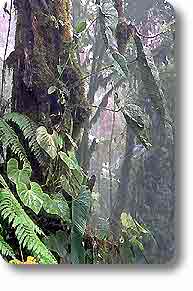
 |
Otonga Strict Nature Reserve |
Points of Interest |
|
|
|
 |
On the western slopes of the Andes, the Otonga Strict Nature Reserve was established. It is an area of great scientific value for the presence of animal and vegetal species which have already disappeared from the rest of the Country and which are sometimes still unknown by scientists. The term "Otonga" derives from the name of an earthworm living in this forest, whose size (it can reach a length of one meter and a half) often leads indigenous people to confuse it with a curious worm-like amphibian without legs, living underground. In the Reserve, the average annual temperature goes from 18 to 24°C, and rainfall from 3,600 to 5,400 mm; therefore, you can distinguish only two seasons: one characterized by great rainfalls from December to May, and the other with minor rainfalls from June to November. The great annual average relative humidity (87%) influences two local phenomena: fog and dew, two forms of condensation characterizing the area of the Reserve. Water plays an essential role in the region, since it is an integrating element of the soil; in the area, thanks to the maintenance of the vegetal soil surface, four big rivers spring (Esmeraldas, Lelia, Las Damas, Samborondon) with good-quality water which is also used by the surrounding regions. The scientific station of the Otonga Reserve is situated at the edges of the provinces of Pichinca and Cotopaxi, between the 850 and 2,300 meters above sea level, and two precise environmental typologies can be found here: the higher mountain area corresponding to the typical cloudy woodland, and the lower part belonging to the tropical rainforest; these typologies include different ecosystems containing extremely varied and diversified forms of life. |